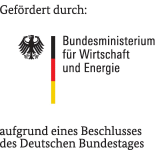The aim of the project is to improve the experimental prediction of the sound level spectra emitted by ships and propulsion systems. In contrast to the usual approach of deriving the sound level prediction solely from measurements in the cavitation tunnel, acoustic measurements are also to be carried out in the towing tank and included in the prediction.

| Title: | Prediction of sound level spectra of ships based on hybrid measurement |
| Term: | 09/2019 – 02/2022 |
| Project Manager: | Kay Domke |
| Founding: | Federal Ministry for Economic Affairs and Energy |
| Project administration: | EuroNorm GmbH |
| Reg.-No.: | 49VF190016 |
On the basis of hybrid measurements, a concept of sound pressure level analysis is to be developed with which the measurement results of the sound measurements of the towing tank and cavitation tunnel can be combined and compiled into a meaningful overall result. It is particularly important to take into account the special characteristics of the respective test facility. The development of the hybrid sound pressure level prediction includes the extension of the measurement procedures in the towing tank to minimise the background noise for the passing ship model and the extension of the measurements in the cavitation tunnel into the range of Froud’s similarity to generate comparable spectra. For the cavitation-free operating points of the ship (propeller), accurate predictions of the radiated sound level spectra can already be worked out from the measurements in the towing tank. If cavitation occurs, the noise level measurements in the cavitation tunnel are decisive for the prognosis. By comparing the measurements in both test facilities, the accuracy of the transfer of the sound levels measured in the cavitation tunnel to free-field conditions can be tested. Since often only one propeller of twin- and multi-screw ships is measured in the cavitation tunnel, the necessary corrections to take into account the influence of several propellers on the sound spectra can be derived from the towing tank measurements and procedures can be checked.
The experimental investigations are to be accompanied by theoretical work. The aim is to obtain knowledge about simulation results on sound propagation in the towing tank, taking into account wall and bottom reflections, as well as the inclusion of the beach. Boundary element methods can provide information on a favourable positioning of the sound sensors. CFD calculations for the cavitation tunnel measurement section will also be carried out. This will consolidate the knowledge of sound propagation in this specific test facility and will contribute to the evaluation of the sound level spectra measured later.
For the conversion of measurements on the model scale to full-scale executions, recommendations are to be worked out on how a conversion to twin-screw vessels can be carried out. It is important to note that the two-pole theory must be taken into account for propulsion systems in which the propeller blades do not have a fixed phase relation to each other